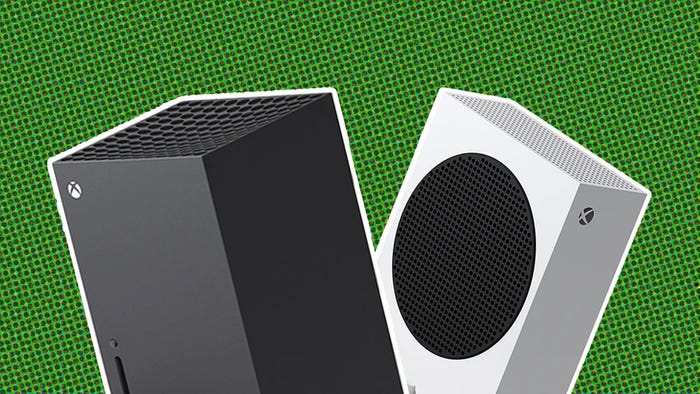
Featured Blog | This community-written post highlights the best of what the game industry has to offer. Read more like it on the Game Developer Blogs.
Unity Addressables: The Final Quiz Analysis
Last week we quizzed you on Unity Addressables. This time, we analyze the results of this quiz, including the top answers the community has chosen. Curious?

This post on Unity Addressables Quiz was originally published with its original formatting in The Gamedev Guru's Blog
Heya, Unity Addressables fan.
Last week, I posted a short but powerful article detailing three Unity Addressables benefits for your game. The article was very well received, thanks for your active participation.
Just at the end of that post, you were given the chance to test your knowledge in Unity Addressables through a short quiz.

Addressables-Quiz-Thumbnail
The goal I had in mind when creating the quiz was to help you become aware of the areas you might be less familiar with, so you can get to develop your skills where you need the most.
I'll confess that, initially, I didn't expect many people to go through the quiz. After all, quizzes can be daunting and, as usual, there's this extra babbling coming from me.
But to my surprise, the quiz results well outperformed my expectations. I'm really happy to see that so many people accepted the challenge. You all rock!
I got some interesting statistics out of the quiz. Here are some figures I wanted to share with you:
The greatest part of the people who started it, about 80%, actually were determined enough to finish it
The average score was about 12, which is pretty damn good for an API that was only introduced recently
Less than 5% of the quiz participants fell in the Troll Guru rank
About 50% are part of the Apprentice Guru group
Over 40% of the participants scored enough to be Enlightened Gurus
But only 5% made it to be considered The Final Boss Guru
So, congratulations if you were part of the quiz experience!
And independently from the score you got, I am sure it will not take you much effort to reach the production-level required score of 20+. I'll be helping you along the path.
In this post, I will explain the most interesting challenges posed in the quiz. Some answers might differ depending on your particular context, so make sure to comment at the end of the post if you had a complementary experience.
If you didn't complete the quiz before, do it now before reading further.
Do not cheat. I'll know.
What were your results? Are you a Troll Guru, an Apprentice Guru, an Enlightened Guru or The Final Boss Guru? Share your results in the comments section.
Trusting that you finished it, let's have a look at the questions and some of the answers. The format should be self-explanatory, but I admit I could have chosen less cheesy graphics for it— yes, that's me.

funny-review
Question 1: Intense Memory Pressure
An angry player leaves a 1-star review because your game uses too much memory. You...

crying-smiley-transparent
Answer in public, telling the player to upgrade their device and then come back
This is a popular answer somehow. As much as we might feel like answering this, chances are, we have been too busy (or lazy) to implement a proper architecture. Blaming players for playing with a brick-phone won't get us more sales, so a better strategy is to fix our mess.

smiley_neutral
Switch to a more advanced texture compression method, e.g. ETC2 to ASTCThis is helpful and you should indeed switch to more advanced compression methods, where possible. But this solution will only take you so far. You'll get moderate gains in memory usage and texture quality, but they'll not be enough to cover your memory pressure issues.

smiley_angry
Split your scenes into sub-scenes, so less content is loaded in memory
In general, sub-scenes used to be a good solution. I've used them in the past with great success. However, if you are having bad reviews already, chances are it is too late to introduce such a massive change in the architecture of your game. Better to look somewhere else.

smiley_happy
Implement an asset lazy-loading mechanism through AssetReferencesOver 75% of people agreed on this, that's great.
AssetReferences are likely to give you the biggest gain for the buck. The migration to this workflow is usually straight-forward and much easier than the other alternatives.
However, be aware that, in some cases, it might be hard to work around the asynchronous requirements of the Unity Addressables API.

laptop-coffee
Question 2: Endless Loading Times
You press the play button. By the time your in-game scene is loaded, your coffee is cold. You...

crying-smiley-transparent
Blame the artists and ask them to put every texture into atlases. Also, you buy a faster PC10% of the subscribers chose this one. I love you guys.

smiley_angry
Reduce the texture size globally, so asset loading is much faster. You don't submit these meta file changes in your versioning systemI've done this a few times recently. It works.
However, the pay to price is high. Your versioning system might go nuts and your changelists will be full of garbage. This is indeed hard to manage, as if you ignore these temporal texture import settings modifications, the real changes will mostly go unnoticed and won't be submitted.

smiley_neutral
Create custom scenes that contain just the functionality you are working onCreating sub-scenes for faster iterations might be a possibility for your game, but in my experience, they tend to be left unmaintained. With time, they break and one might spend more time fixing them than the gain you eventually had back then.
Consider implementing sub-scenes only if you don't see these problems in your project.

smiley_happy
Remove direct references and add indirect references instead, so only the required assets are loadedIndirect references for the winner.
Direct references will implicitly ask Unity to load all their content as soon as the script holding them is instantiated. Indirect references, however, gives you full control over the when/how/what. That means, you can delay loading until you need it, if at all, saving you from unnecessary loading times and wasted memory.

Unity-Addressables-Play-Script-Mode
Question 3: What Play Mode Script?
You are currently implementing materials for your new characters. You want to try Addressables, so in the Play Mode script section of Addressables, you select...

smiley_neutral
Fast Mode: we want it always fast, after allThis is a valid option, but fast mode does no validation at all of important aspects of development, such as asset dependencies and cross-references.
If there are no substantial changes in the content you're working on, fast mode will be fine. Otherwise, we can do better.

smiley_angry
Packed Play Mode: yes! we want our characters to be packedNo! The Packed play mode requires you packing the assets every time you do a change in your addressable asset contents, otherwise you'll end up loading the old versions.
You don't want to be packing every time, it's a huge time sink.
But you might consider packed play mode once you're done working with addressables content to gain faster iterations, as these assets will require minimum processing while being loaded.
35% of the Guru Challengers chose this answer.

smiley_happy
Virtual Mode: it sounds safer than fast modeVirtual Mode is the option I suggest you using while actively working on your addressable content.
The virtual mode is fast enough to keep iteration times short and at the same time, it'll give you useful validation checks to avoid screwing it up and finding out the mess way too late.

Question 4: Oops... Error Diagnosing
You try Addressables but you don't recall your assets looking pink in your Android device. How weird! You...

smiley_neutral
Enable the ADDRESSABLES_LOG_ALL symbol, make a development build and check the logcat logsIf you came to me with such a description, I wouldn't necessarily take you down this road directly.
The main issue with adding scripting defines and checking the logs on the device is the time it takes to prepare such a build, deploy it, test it and gather useful information from the logs.
There are indeed better ways to tackle this, but certainly keep this as a backup option if they fail to give you an accurate diagnosis of the problem.

smiley_happy
Set the play mode script to Packed Play Mode and run it in the editor to further diagnose the issue with the Addressable ProfilerEmulating as much as you can the environment in which the content will be displayed is my preferred option, as it takes the least total amount of time. You do this by selecting the packed play mode in the main Addressables Window settings. The Unity Editor will load the addressable resources directly from the built content, so this is expected to give you a similar behavior than on the device, as long as the editor can load such a content.
You can also try running it in virtual play mode, which does some validation on top of the traditional asset loading pipeline for addressables.
You can also count on the Addressable Profiler's help, a tool that will inform you about the addressable operations that are taking place at all times in your game.
This answer was correctly chosen by 66% of the participants.

crying-smiley-transparent
Post in StackOverflow and Unity Answers12% of you see value in posting questions on these platforms, as there are always people willing to help. But preparing a reproduction project, posting and refreshing your screen with F5 is likely to take you much longer than just diagnosing and fixing the problem yourself. Trust me, this should be your last resort.

Unity-NSFW
Question 5: Heavy Video Packing
You want your mp4 trailer video to be included in your game. You...

smiley_neutral
Toss it into the StreamingAssets folderThe StreamingAssets directory works just fine, especially when coupled with famous video plugins you find in the store. The assets stored in that directory are not packed together like Resources do but rather left as individual files when your game is installed. Its simplicity and easy I/O is the reason it is the default method of playing video.
The biggest con is that the assets stored in StreamingAssets are forcefully packed in your distributed game from the beginning, so they are likely to take a lot of space in your build.
Why would your users have to wait 5 minutes longer just to download the credits video that will be played at the end of a 30+ hours game?

smiley_angry
Mark it as Addressable, add a "videos" label to itSure, making it addressable sounds cool. But adding a "videos" label to it?
Usually, labels are used to download all assets belonging to that label category at once. Unless you have a very specific use case, doing this is not likely to help your project.

smiley_happy
Mark it as Addressable, adding it to a "videos" group with the following attributes: static content, no compressionVideos are not likely to change, so making them static makes sense. Also, there's no need to compress them, as the used video codec should already offer you compression. Adding LZ4 or LZMA compression on top of this already-compressed content will only incur in CPU overhead. Your users' battery will drain faster as well. I'm sure your players wouldn't appreciate it.

smiley_neutral
Mark it as Addressable, adding it to a "videos" group with the following attributes: dynamic content, LZMA compressionDynamic, compressed content is by far the most commonly chosen answer. But it is a misleading one.
For the reasons stated above, you should avoid using compression on already compressed content. And videos are often enough very static, so by marking that group dynamic you wouldn't be helping your asset building workflows.
Most people (46%) thought this was to best option.

Unity-Addressables-LoadAssetAsync
Question 6: Memory on Instance Releasing
You loaded your asset once through LoadAssetAsync. Now you're done with it, so you...

smiley_angry
Call Addressables.Release, so it is immediately releasedThere's no guarantee that the memory will be freed right away, as the current documentation correctly points out. But do not worry about it too much, it will be correctly freed by Unity. 23% popular.

crying-smiley-transparent
Call Destroy, we better make sure we free that memory upAddressables is, as of now, unaware of traditional Unity instantiation and destroy mechanisms. If you do so by yourself, you are doing it at your own risk and bookkeeping. If you mess it up, the API and OS are unlikely to be happy about it. And you will know.

smiley_happy
Call Addressables.Release, so it is released at some point in the futureThe documentation implies that the memory occupied by addressable assets will be freed at some point in the future after calling the Unity addressables release method.
You can count on Unity smartly deciding when it is time to do just so (e.g. low memory situations, Resources.UnloadAllUnusedAssets, etc.). You guys got this one right!

Unity-Addressables-LoadAssetAsync-Yield
Question 7: Loading with LoadAssetAsync
You're excited about doing your first Addressables.LoadAssetAsync. So you call it and use its returned handle like...

smiley_angry
while (handle.Status == AsyncOperationStatus.Succeeded) ;I confess to you that I've tried this method to try to force a synchronous behavior out of the Addressables API (e.g. Photon Networking under Unity Addressables).
But you can guess what happened after seeing the answer's smiley. My computer's fan started spinning insanely fast and I had to reboot the computer as the OS became utterly unresponsive. I'm not trying this again any time soon, thanks.
Doing this loop is likely to cause a deadlock, as part of the loading process is executed in Unity's main thread. And that line of code is the easiest way to block your main thread.

smiley_happy
await handle.Task; or yield return handle;These two solutions are asynchronous ways of waiting for the loading process to finish before continuing with our code. That's great stuff for you and me, as they offer great readability and are easy to maintain.
However, be aware they incur on some performance penalty.

smiley_happy
handle.Completed += OnLoadCompleted;This is the simplest and yet most powerful option to do something after the asset has been loaded into memory.
Keep in mind, though, that you're introducing lambdas and/or callbacks. They will reduce the readability of your code and therefore make your programming style more dangerous. Unless you are a pro, of course.

The-Gamedev-Guru-Recycle-Bin
Question 8: Migrating to Better Workflows
You have a bunch of skyboxes living as direct references in your Skybox manager as a list of materials. Those are eating all your memory, so you...

smiley_angry
Move them into the Resources folder and start using Resources.Load as you need themNo! Bad boy!
Don't ever use the Resources directory for heavy assets. They are a major cause of pain, tears and burnouts in large scale projects. It is indeed surprisingly easy to misuse the Resources API. Read more info on why it is so here

smiley_neutral
Put all skyboxes in an asset bundle that you will load appropriatelyAsset bundles were a much needed solution back then. But we have better solutions now with Unity Addressables.
The issue is that working with asset bundles is way more tedious and expensive to implement and maintain than just using Unity Addressables. Unless you're doing a port and you don't want to touch much of the original systems, try to avoid them.

smiley_happy
Replace the list of skybox materials with a list of AssetReference's and load them as you needUsing Unity Addressables is probably the best option to tackle this kind of memory issues.
One of the reasons it is such a silver bullet is because you can easily migrate from the most popular approaches of managing content such as direct references, resources API, additive scenes and asset bundles.
Unity Addressables are a simpler way to develop more efficient games.

smiley_neutral
Decrease the skybox texture sizesTweaking the texture import settings works up to a point. This has an upper ceiling limit, as you cannot infinitely go lower in memory usage (and quality) without re-categorizing your 3d game into pixel-art. This just doesn't scale well.

Chances are very high that you didn't reach the rank of The Final Boss Guru.
But that's good, because that means there's massive room for improving and optimizing the way you develop and ship games. And what is more important, your players will appreciate the expertise you build in each of these areas. The only place you want to read 1-star reviews is at the app store of your competitor's game.
Given the importance of delivering enjoyable experiences to your players, I will share something with you.
Between you and me: I have a work-in-progress plan for maximizing the potential of your game with Addressables. In the upcoming weeks, I will be revealing to you more information about the Unity Addressables level-up program I'm developing. That program is going to get you to the production level you need to deliver the games people will deeply enjoy (purchasing and) playing.
To make sure you don't miss on the upcoming content, subscribe now to the newsletter. I'll keep you posted.
Till then, comment below on what you would like to learn the most and also how you plan to use Unity Addressables in your project.
See you soon on the blog!
Rubén
Read more about:
Featured BlogsAbout the Author(s)
You May Also Like













